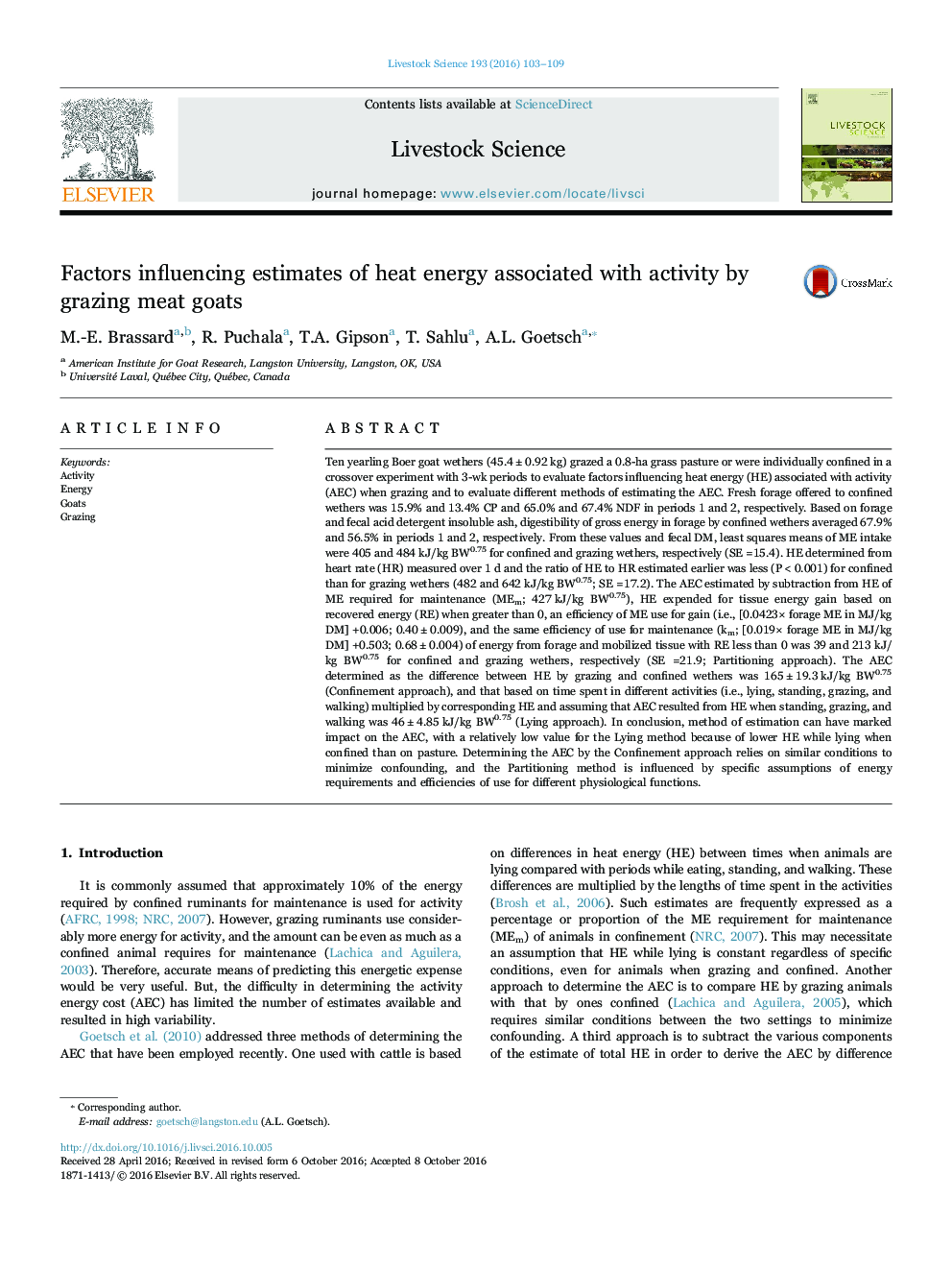| کد مقاله | کد نشریه | سال انتشار | مقاله انگلیسی | نسخه تمام متن |
|---|---|---|---|---|
| 5543040 | 1553939 | 2016 | 7 صفحه PDF | دانلود رایگان |
عنوان انگلیسی مقاله ISI
Factors influencing estimates of heat energy associated with activity by grazing meat goats
ترجمه فارسی عنوان
عوامل موثر بر برآورد انرژی گرمایی مرتبط با فعالیت توسط بز گوشت گوسفند
دانلود مقاله + سفارش ترجمه
دانلود مقاله ISI انگلیسی
رایگان برای ایرانیان
کلمات کلیدی
فعالیت، انرژی، بز ها، گاو نر
موضوعات مرتبط
علوم زیستی و بیوفناوری
علوم کشاورزی و بیولوژیک
علوم دامی و جانورشناسی
چکیده انگلیسی
Ten yearling Boer goat wethers (45.4±0.92 kg) grazed a 0.8-ha grass pasture or were individually confined in a crossover experiment with 3-wk periods to evaluate factors influencing heat energy (HE) associated with activity (AEC) when grazing and to evaluate different methods of estimating the AEC. Fresh forage offered to confined wethers was 15.9% and 13.4% CP and 65.0% and 67.4% NDF in periods 1 and 2, respectively. Based on forage and fecal acid detergent insoluble ash, digestibility of gross energy in forage by confined wethers averaged 67.9% and 56.5% in periods 1 and 2, respectively. From these values and fecal DM, least squares means of ME intake were 405 and 484 kJ/kg BW0.75 for confined and grazing wethers, respectively (SE =15.4). HE determined from heart rate (HR) measured over 1 d and the ratio of HE to HR estimated earlier was less (P<0.001) for confined than for grazing wethers (482 and 642 kJ/kg BW0.75; SE =17.2). The AEC estimated by subtraction from HE of ME required for maintenance (MEm; 427 kJ/kg BW0.75), HE expended for tissue energy gain based on recovered energy (RE) when greater than 0, an efficiency of ME use for gain (i.e., [0.0423à forage ME in MJ/kg DM] +0.006; 0.40±0.009), and the same efficiency of use for maintenance (km; [0.019à forage ME in MJ/kg DM] +0.503; 0.68±0.004) of energy from forage and mobilized tissue with RE less than 0 was 39 and 213 kJ/kg BW0.75 for confined and grazing wethers, respectively (SE =21.9; Partitioning approach). The AEC determined as the difference between HE by grazing and confined wethers was 165±19.3 kJ/kg BW0.75 (Confinement approach), and that based on time spent in different activities (i.e., lying, standing, grazing, and walking) multiplied by corresponding HE and assuming that AEC resulted from HE when standing, grazing, and walking was 46±4.85 kJ/kg BW0.75 (Lying approach). In conclusion, method of estimation can have marked impact on the AEC, with a relatively low value for the Lying method because of lower HE while lying when confined than on pasture. Determining the AEC by the Confinement approach relies on similar conditions to minimize confounding, and the Partitioning method is influenced by specific assumptions of energy requirements and efficiencies of use for different physiological functions.
ناشر
Database: Elsevier - ScienceDirect (ساینس دایرکت)
Journal: Livestock Science - Volume 193, November 2016, Pages 103-109
Journal: Livestock Science - Volume 193, November 2016, Pages 103-109
نویسندگان
M.-E. Brassard, R. Puchala, T.A. Gipson, T. Sahlu, A.L. Goetsch,
